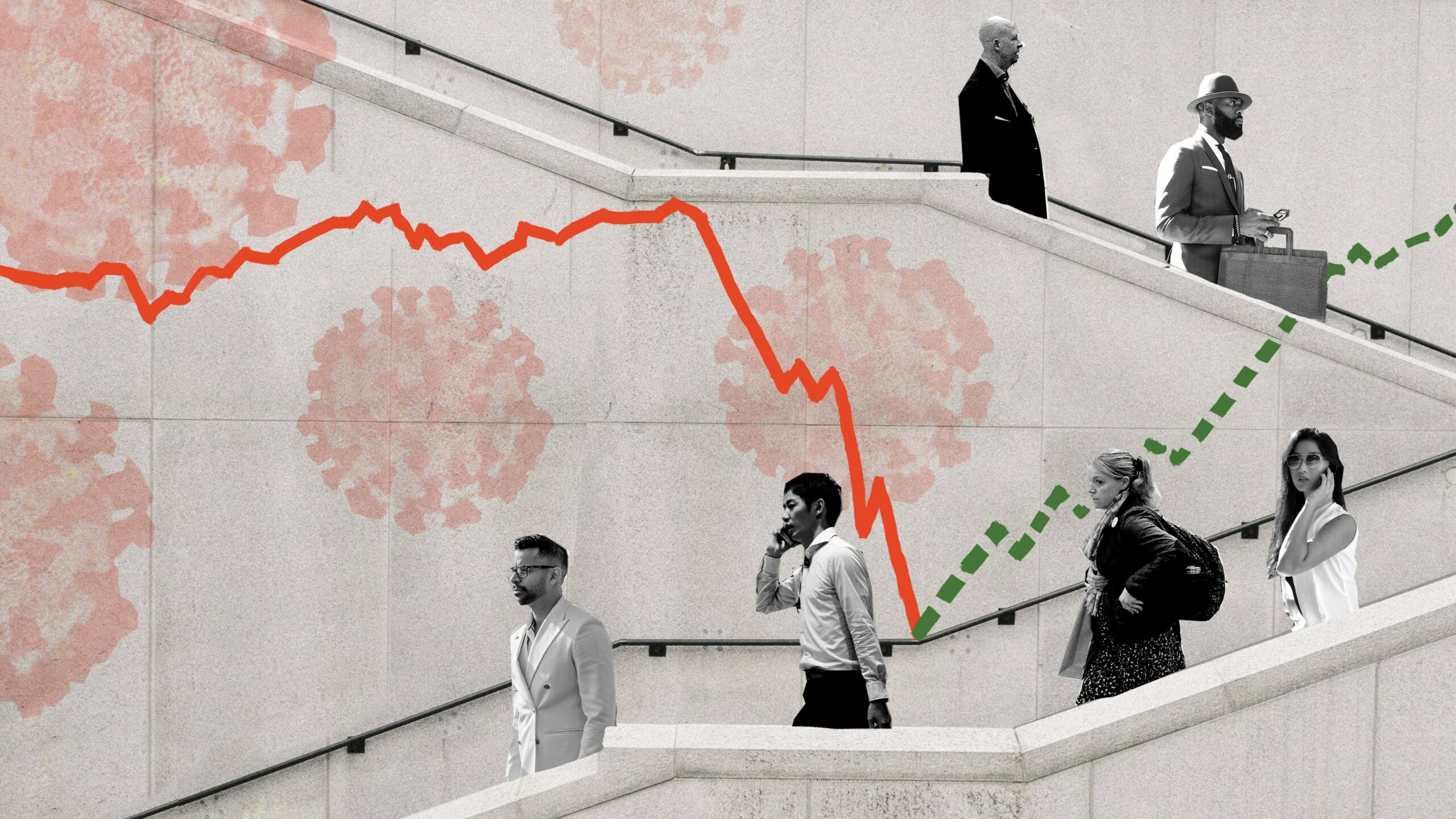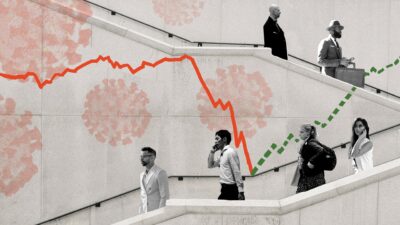Sandra Peter and Kai Riemer

The watch industry on Corona Business Insights
How COVID-19 accelerates the polarisation in the global watch industry. What does it mean for luxury brands, and will smart watches continue their takeover of the consumer market?
As COVID-19 sets out to change the world forever, join Sandra Peter and Kai Riemer as they think about what’s to come in the future of business.
Shownotes
How the pandemic changed the watch industry
COVID-19 and the Swiss watch industry
Swiss watch industry in its worst ever crisis
The pandemic speeds up changes in the watch industry
The Apple Watch is growing its success
Apple outsells the Swiss watch industry
The emerging role of wearables in detecting COVID-19
Our previous discussion on the fashion industry during COVID-19
This episode is part of a podcast series covering what COVID-19 will mean for the business world, where we look at the impact on the economy, businesses, industries, workers and society. This is part of our ongoing coverage of the impact of COVID-19 on the future of business.
Follow the show on Apple Podcasts, Spotify, Overcast, Google Podcasts, Pocket Casts or wherever you get your podcasts. You can follow Sydney Business Insights on Flipboard, LinkedIn, Twitter and WeChat to keep updated with our latest insights.
Send us your news ideas to sbi@sydney.edu.au.
Dr Sandra Peter is the Director of Sydney Executive Plus at the University of Sydney Business School. Her research and practice focuses on engaging with the future in productive ways, and the impact of emerging technologies on business and society.
Kai Riemer is Professor of Information Technology and Organisation, and Director of Sydney Executive Plus at the University of Sydney Business School. Kai's research interest is in Disruptive Technologies, Enterprise Social Media, Virtual Work, Collaborative Technologies and the Philosophy of Technology.
Share
We believe in open and honest access to knowledge. We use a Creative Commons Attribution NoDerivatives licence for our articles and podcasts, so you can republish them for free, online or in print.
Transcript
Intro From the University of Sydney Business School, this is Sydney Business Insights.
Sandra And this is Corona Business Insights. I'm Sandra Peter.
Kai And I'm Kai Riemer.
Sandra And we're back unpacking the impact of COVID-19 on business, the economy, industry, government, workers and society, and looking at the effects of the pandemic.
Kai And this podcast is part of a larger initiative by the University of Sydney Business School.
Sandra You can find our COVID Business Impact dashboard online at sbi.sydney.edu.au/coronavirus.
Kai And today we talk about the impact of the COVID-19 pandemic on the watch industry.
Sandra And the global watch industry is actually very unevenly distributed. So we thought today we'll focus separately on the luxury or the high-end watches, the consumer watches and then also the newcomers the smartwatches, although they've been around for quite a while now. We'll start slightly before the pandemic because this industry is one in which the shift that was already underway before the pandemic started has actually been accelerated greatly since COVID-19.
Kai So the phenomenon that we are looking at is the polarisation of the watch industry. And that happens both within the luxury and high-end segments of the market and more broadly in the marketplace, where the middle of the market and consumer watches are more and more challenged by the emergence of wearables, smart devices, most importantly, the Apple Watch. And then devices like Fitbit, which, of course, are fitness devices that also display the time and compete for the all-important wrist real estate.
Sandra So it's important to have a picture of what the industry looked like before the pandemic. A report for instance, by Morgan Stanley published just in March this year, but looking back at 2019, really confirms that the last couple of years have cemented the leading position that only seven brands have in the luxury or the high-end segment of the market and has led to these brands strongly outperforming the other brands, the majority of which are either stagnating or worsening.
Kai And so these brands Rolex, Omega, Longines, Cartier, Patek Phillippe, Tissot and Audemars Piguet.
Sandra And Richard Mille, coming strongly from behind will probably join the exclusive billionaires club, that is brands that make over a billion dollars in sales every year.
Kai And that's seven or eight brands out of about 600 Swiss watch brands, many of which might not actually survive the pandemic.
Sandra And the watch industry really is apart from all other segments of the luxury industry in that you have these privately held brands which perform much better than all of the listed companies do. So privately held brands like Rolex or Patek Phillippe, or Audemars Piguet or Richard Mille, take up about 35% of the market and then huge conglomerates like Richemont or LVMH, or the Swatch Group, which have about 37 brands combined under their collective umbrella, only have about 55% of the market share.
Kai Then there's a long tail of a few hundred smaller houses that are quite exclusive, many of which are struggling, not just now, but also before the pandemic. And then there's the wider watch market, consumer watches, the middle segment, and of course smartwatches. And just last year, a milestone happened where, for the first time, off the back of very strong sales, Apple actually outperformed the entire Swiss watch industry in unit numbers. So Apple Watch shipments grew by 36% in 2019 to nearly 31 million units, whereas the entire Swiss watch industry, including of course, consumer brands like Swatch and mid-price brand like Tag Heuer, only shipped an estimated 21 million units which is a 13% decline. So while the high-end market actually does quite well, the brands that we've just mentioned, what is struggling is the consumer segment where a lot of the mass-produced watches sit. And on top of this there is of course, all other wearables. Apple has a 55% market share in the smartwatch market, then there is Samsung, and other brands, and of course fitness trackers like Fitbit which also compete now increasingly with the consumer watches.
Sandra And the predictions before the pandemic hit were that this trend will continue and smartwatches taking over market share from consumer watches, but also with luxury watches continuing to grow especially at the very high end with McKinsey for instance, predicting that luxury sales will triple by 2025.
Kai So fast forward now to the pandemic in the beginning of 2020. And the Swiss watch industry is in deep trouble. So it was already forecast that revenue would be down by 40% in the second quarter, which turned out to be actually a 62% revenue drop for the industry with retail outlets across the world closing down and of course, consumers staying home. Much like the fashion industry and other parts of retail the watch industry was impacted quite severely. And so for the first half of 2020, that translates into a 36% fall in exports and unit shipments being down by 45% for the entire Swiss watch industry.
Sandra And this again went to strengthen the trend that we discussed beforehand that of polarisation for the luxury watch industry. Of course, they were hit quite hard, especially since only about 5% of the luxury watch industry had any online e-commerce channels to begin with. But let's remember they did well even during the last financial crisis there were steadily increasing whilst everything else was suffering. Yet groups like the Swatch Group, which includes a lot of the consumer brands as well suffered severely with the reporting half-year losses for the first time since they were founded, and luxury groups like Richemont having unprecedented losses with about 47% drop in group sales in the first quarter of its financial year that ended in June.
Kai So for the luxury brands and the high-end market, of course, a transition into e commerce is not as easy many have for years resisted any move to electronic commerce because of course, the consumer experience cannot be recreated in the online channel. Many brands also fear international price transparency with luxury tax in many jurisdictions quite different prices end up being quite different.
Sandra For Rolexes that is about two and a half grand price difference depending on whether you're buying it in Canada or in China.
Kai And so while some brands have hastily set up or accelerated their online strategies to bring their sales online for many brands, the opportunity online was not in actually selling their watches, but connecting customers via Zoom, for example, with the designers, with the CEO of the company, the people responsible for making the watches and we're talking high-end market here where a single timepiece might set you back a six figure dollar amount, where the customer experience is quite an exclusive one. And so while the luxury and high end market are weathering the storm, finding some opportunities, but I expect it to bounce back quite strongly after the pandemic, and we're already seeing this in China to a certain extent. What is interesting is that at the other end of the market, the polarisation, the move from traditional consumer watches to wearables is already accelerating during the pandemic with Apple for example, in its April to June quarter, seeing a 16% increase in its wearables sales and that includes headphones and Apple Watches being up 16% in the April to June quarter and remember, Swiss watch sales was down 36% in the first half of the year.
Sandra So as we move out of or on with the pandemic, depending on where you are, whilst we're all at home, still exercising, still buying Fitbit and Apple Watches, we're also seeing the same type of revenge consumerism that we've seen and discussed with other luxury markets.
Kai And remember, we talked about this in the fashion episode.
Sandra Same as we've seen with shops like our Hermes, China being the first to end its lockdown was also the first one back buying luxury items. And we've seen huge jumps across the board. Whilst sales had fallen 80% during the lockdown, they jumped 76% in May and 60% in June compared to last year. And this of course, is Switzerland's second best watch market after the US, and the projection is that other countries will follow suit. South Korea is also experiencing a surge in watch sales jumping 34% in June. But of course, places like the US and Hong Kong are still very much down. And since the Chinese consumers are not traveling anymore, whatever gains we're seeing in China, it's actually taking away from other markets like the US or like Japan or Australia.
Kai And that might actually continue. So watches in these markets might not do as well in the next couple of years, but by and large, it is expected that the luxury market will actually do quite well. And while it's projected that 50 to about 100 Swiss brands might disappear, the large brands will do quite well, and the polarisation will be ongoing. Also, luxury market is usually quite insulated from the economic downturn. So many people might lose their jobs which will hit the mid-price market much harder than the luxury market. And remember, the stock market is still doing quite well, so people who draw most of the income from investment rather than employment will still flock to the luxury brands.
Sandra So overall, what we're seeing is that COVID-19 really just accelerated this polarisation trend that we were seeing in the market and it's likely to continue accelerating it not only due to lock downs and restrictions on the market, but also due to the pandemic itself.
Kai And we'll put some links in the shownotes. So there's latest research that shows that wearables such as Fitbit and Apple Watches are now successfully used in the early detection of COVID-19 symptoms for example, where sensors such as skin temperature, heart rate, or measurement of oxygen levels, can be used to detect COVID-19 even before a patient might have active symptoms. So the COVID-19 pandemic might actually accelerate and move towards wearables and smartwatches as those health aspects of these devices become more and more relevant and front of mind of consumers.
Sandra But that's all we have time for today.
Kai This was Corona Business Insights. Thanks for listening.
Sandra Thanks for listening.
Outro From the University of Sydney Business School, this is Sydney Business Insights, the podcast that explores the future of business.
Close transcript






